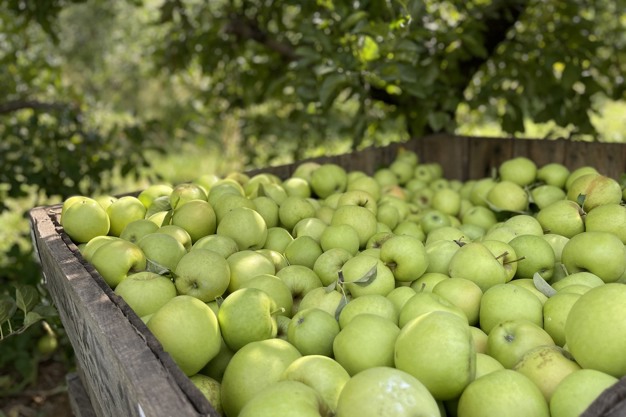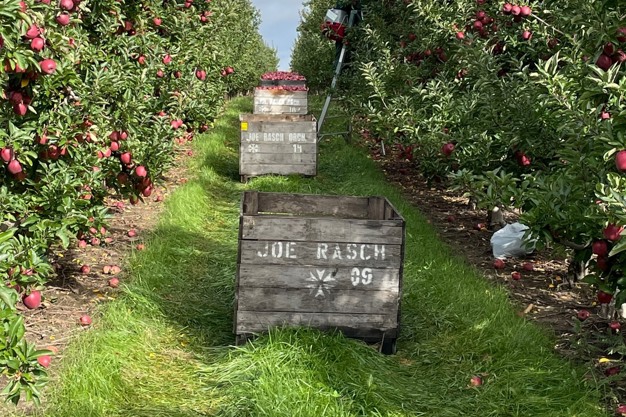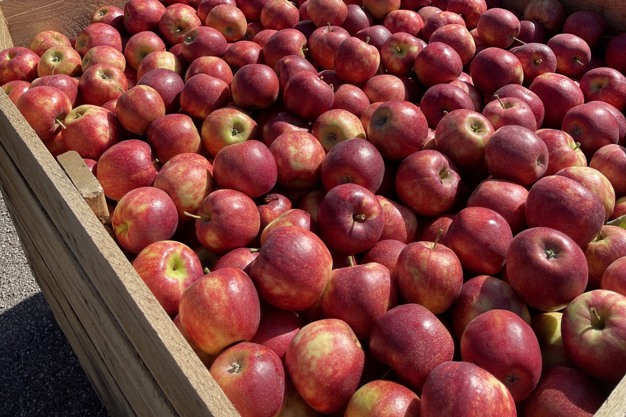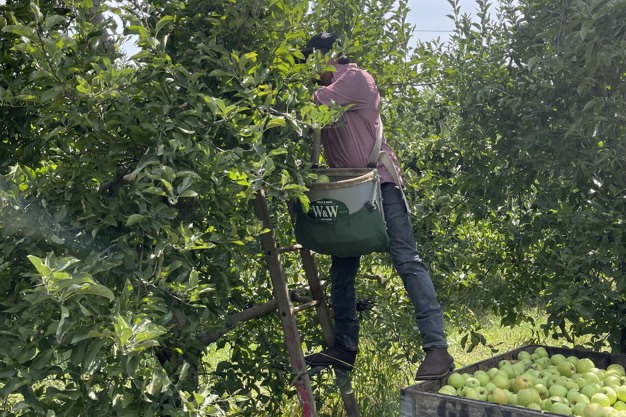The U.S. Apple Association held its 2023/2024 wrap-up this week which included insights into crop estimates, exports, and more. Here are highlights from the session, hosted by Christopher Gerlach, the U.S. Apple Association's director of industry analytics.
Production update
USDA's crop production report comes out annually in August and includes estimates for the top seven apple-producing states in the country. The 236-million-bushel estimate was then revised by U.S. Apple members at their annual Outlook conference to 242 million bushels.
 All photos: U.S. Apple
All photos: U.S. Apple
This month, USDA's Non-citrus Fruits and Nuts reports came out with its estimate of 270 bushels which includes estimate revisions on several states including Washington with 181 million bushels; Michigan (which outproduced New York for the first time since 2016), with 32 million bushels; New York, 30 million bushels; Pennsylvania, 13 million bushels; California six million bushels; Virginia, five million bushels and Oregon, four million bushels.
However, based on acreage totals from the 2022 Ag Census, there are also another 21 million bushels from "other" states which USDA discontinued tracking starting in 2007. This sheds light onto that "other" production in states such as West Virginia, Ohio, and North Carolina. According to the census, along with key growing states such as New York and Washington adding over 12,000 and 9,000 acres, respectively, Wisconsin and North Carolina are also adding significant acreage. In all, the U.S. added around 33,000 of apple-bearing acreage–that is up 10 percent between the 2017 and 2022 Census reports. In declining acreage, states such as California and West Virginia lost acreage–2.5 thousand acres and 1,000 acres, respectively.
While there are sensitivities over the size of apple production in the U.S., Gerlach says a full picture is key. "Not counting these apples doesn't make them go away. Understanding how this increasingly large group of states is moving is critical in helping the industry make informed decisions for long-term planning," he says.

While the USDA reports that the U.S. hit an apple production peak in 2014 at 282 million bushels, this year's estimate is 270 million bushels–however the comparison isn't "apples to apples" given the 2017 production figure includes more states than the 2023 number. He notes if those states are added back in, this is the biggest year in U.S. production.
Farm sizing
The Census also notes developments in farm sizing. "Small farms between 1-49 acres have been decreasing over the last 20 years. The same for the medium farms, 50-179 acres which are down 33 percent over the time period. Large farms are increasing a little bit," he says, adding that the presumption is that the small farms are being aggregated into larger farms. "The extra large farms are also decreasing but what is steadily increasing are those extra large 2000+ acre farms which are up 42 percent over the 20-year period."
The cost of costs
The Census also reports that on expenses, in the last 10 years, total farm expenses grew by 29 percent while fruit tree and nut expenses grew by 49 percent, primarily driven by increased costs in labor and fertilizer. "In 2022 labor accounted for 40 percent of tree and nut farm expenses versus 12 percent for all farms. So definitely more labor intensive than some of the combine harvesting techniques of other commodities," says Gerlach.
Meanwhile, the report indicates that net income for fruit tree nut farms has been decreasing, falling from 6.4 billion to 5.8 billion, down nine percent between 2017-2022. Conversely, all farm net income has increased by 64 percent over the decade.
Apple movement
According to this month's report, there's some development in fresh versus processing. Pennsylvania is moving up in fresh sales as is New York though Virginia is notably up 10 percent year over year in fresh sales. Oregon is also doing approximately 10 percent more in fresh production.

In movement, to date there are 83 percent more Honeycrisp apples at 11 million bushels; 12 million bushels of Red Delicious (about 30 percent year over year), and Cosmic Crisp up 61 percent. Overall inventory as of May is up 33 percent over this time last year.
The key to good fresh apple movement comes in August and September, though the brunt of the movement is going to occur between October-May. "We had a pretty good early season, August, September, but we're still short of that. We're down four million bushels early in the season. So far we're about 14 million bushels behind the previous record season in 2014," says Gerlach, adding that through April, the industry is 19 percent above movement from last year at this time.
Where movement has slowed is on processing apples. "A lot of that has to do with the fact that we had such a good year last year, the processors filled up their storage containers and there wasn't really a processor market to speak of at the beginning of the season," says Gerlach.
Aside from multiple regions, including powerhouse Washington, having good crops, there are other reasons why there are still so many apples. "New production is coming online, especially for varieties like Honeycrisps and Cosmics with higher yields so we're getting more efficient with the trees we do have. There's also better fruit quality and storage protocols which means we're having higher packouts," says Gerlach.
Imports and exports
Meanwhile, on exports, the strength of the U.S. dollar is making exports more expensive and imports relatively cheaper. "We have done a great job since that larger crop in 2014-2015 replacing imports with domestic apples. Following that big season, they were able to cut off the tap on imports. That doesn't happen anymore because our import picture is a big stickier now," he says. In 2014 for example, fresh apple imports were 9.9 million bushels leading into that large domestic 2014-2015 season. In 2023-2024, fresh apple imports are 5.2 million bushels, a decrease of 48 percent over the decade.

There is also declining domestic demand to contend with and this is something the industry continues to examine.
On exports, this year apple exports are up considerably over last year–by 11 million bushels to date. "We're still not offshoring as many as we did a decade ago," says Gerlach, noting factors such as trade policies, the strong dollar, and increased transportation costs all factor into it. "Whatever the reason is, we're still not getting as many of our apples overseas."
He does note market differences–shipments to Mexico are up 48 percent year to date while Canada is down. "Though India has come roaring back since the removal of the retaliatory tariffs at the start of the season. Not quite where we were but last year at this point, we'd sent 31 thousand bushels and we're already up at 1.7 million bushels," says Gerlach.
Pricing and cost developments
Unfortunately, apple pricing is in deflation. "Heading into this season, costs to grow apples were up 34 percent and since harvest, prices are down 11 percent leading many growers to sell at a loss," says Gerlach. "These trends are not sustainable and if something isn't done, especially on the labor front, a lot of these multi-generational farms will throw in the towel."
Looking ahead
Looking ahead to the 2024-2025 crop, reports indicate a strong return bloom with no major frost issues to report. "Replacement plantings continue taking place, but not a lot of new acreage coming online," says Gerlach. "Tree orders this year for delivery in two years from now may be down somewhat given the market conditions."
 For more information:
For more information:
Christopher Gerlach
US Apple Association
Tel: +1 (703) 442-8850
[email protected]
www.usapple.org










